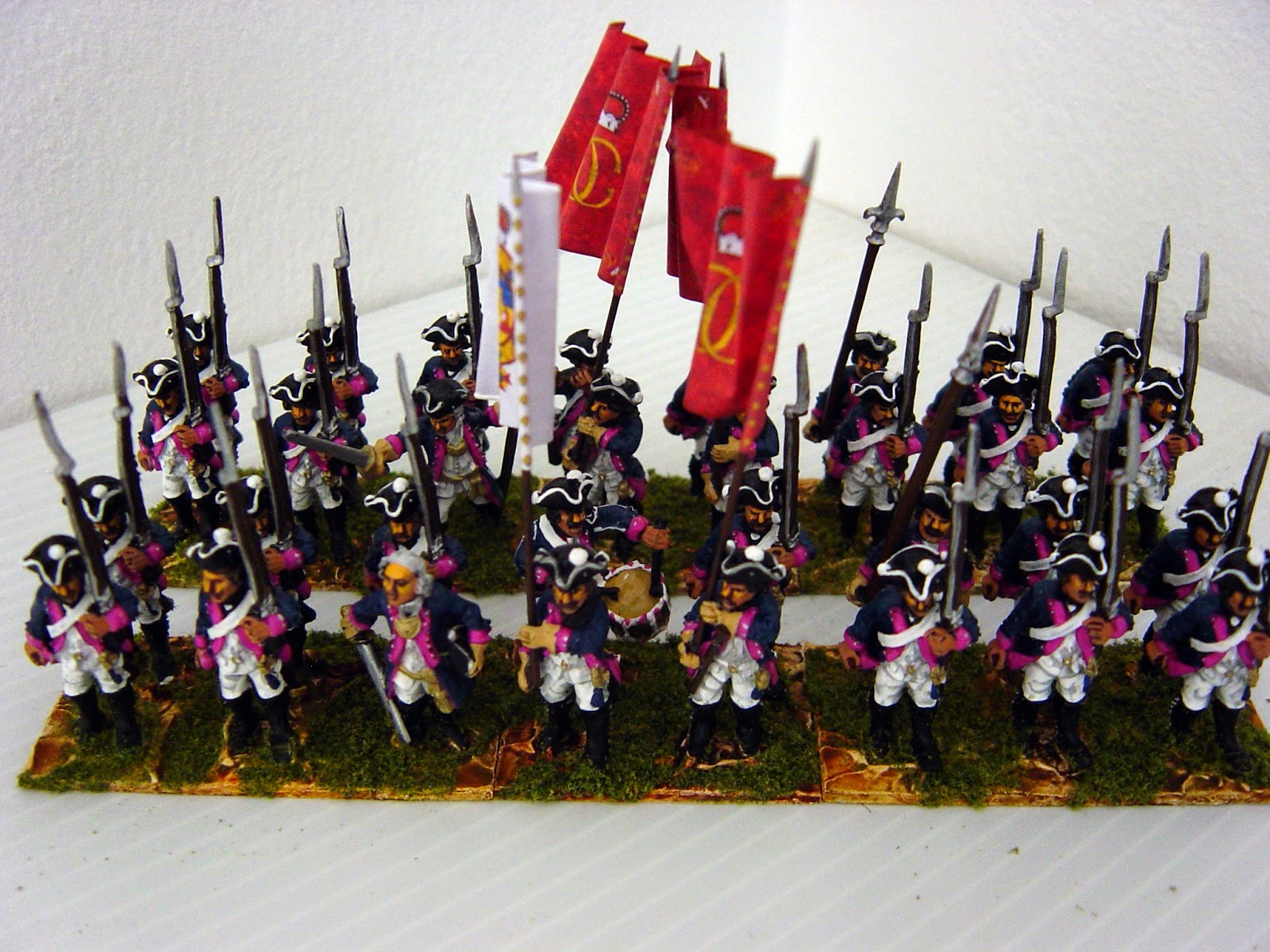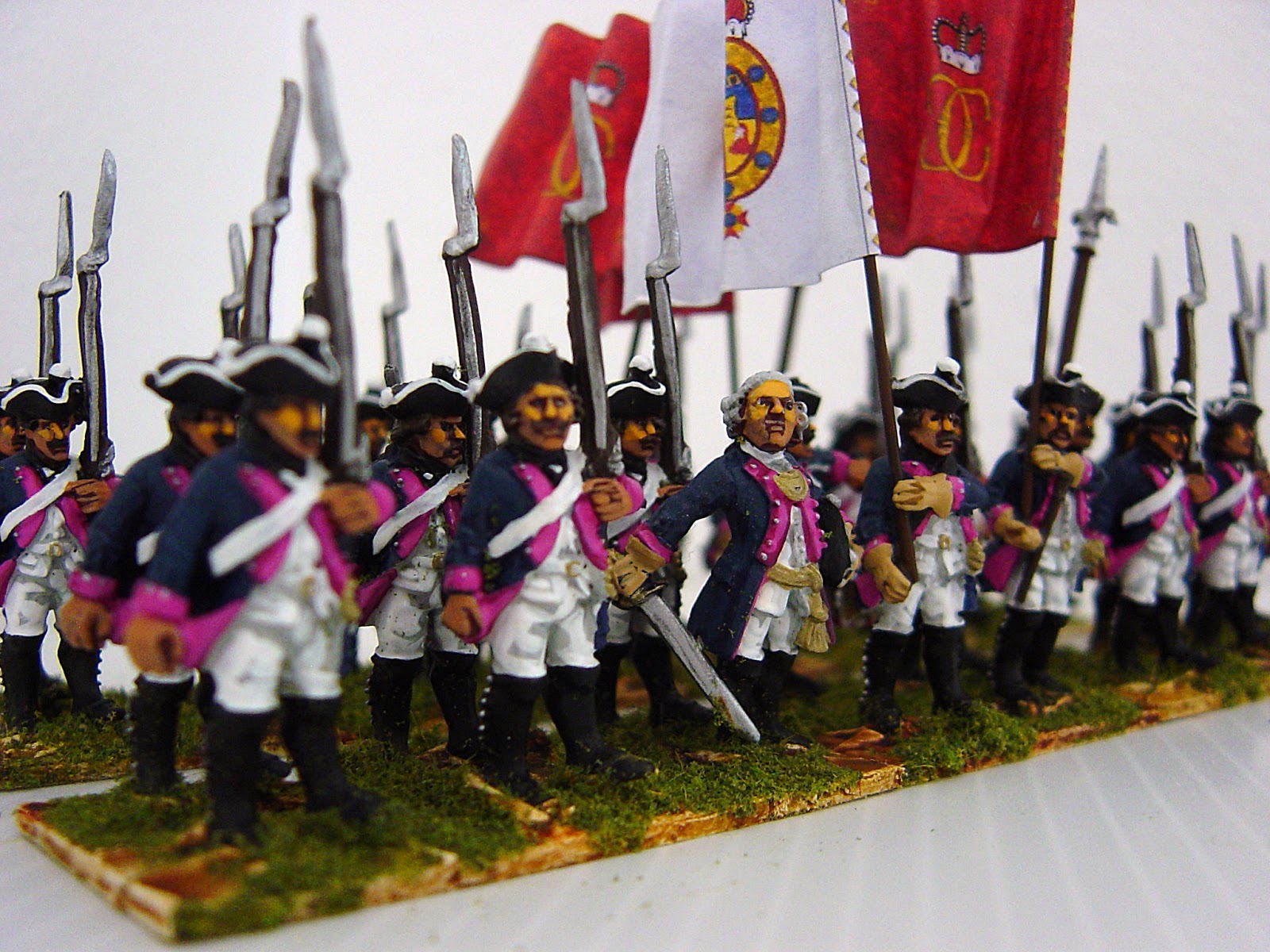Sunday, 28 December 2014
40mm Prussian SYW
Just enough time to squeeze some images in of the Prussians done so far for this 40mm project. Most of what you have seen the last few years has been Austrians and the Prussians have been lagging behind - in fact it was back in September 2011 when you last saw these chaps. The figures are from Trident and, I think, are very pretty. They are actually Hessians for the AWI so here is an irony - I use Hessian figures in 40mm for my Prussians and in 28mm I use Prussian figures for my Hessians.
By the way, the figures above show the first battalion of IR22 Moritz Prince of Anhalt-Dessau. On my desk at the moment are two battalions of IR11 Johann Carl Baron von Rebentisch. I'm not sure when they will be finished as these are very detailed figures and take a lot of time to complete but sometime next month.
Happy New Year to you all. I'm off to Saigon - well Ho Chi Min city as it is these days. In my mind it is still Saigon and who can forget that iconic image of the helicopter leaving the city before it fell.
Monday, 22 December 2014
Württemberg Infantry Regiment Prinz Friedrich Wilhelm
It's been a long haul through the Wurttemberg army but all the 'regular' infantry are done and I have only got the artillery, one light infantry unit, some small cavalry units and one Kreis infantry regiment to do. Now a two week break beckons and we are off to Vietnam for New Years - to Saigon (well Ho Chi Min city). So I wish you all a happy Christmas and New Year and see you back here in 2-3 weeks time.
Wednesday, 17 December 2014
Hessian IR1 Leibgarde zu Fuß - revamped
Cross fertilization!
Please check out my other blog at http://landgraviateofhessen-kasselinthesyw.blogspot.com/
Please check out my other blog at http://landgraviateofhessen-kasselinthesyw.blogspot.com/
Monday, 15 December 2014
Württemberg Infantry Regiment von Werneck
This is the penultimate regiment of Wurttemberg 'regular' infantry. The last one will be done this week. I have Kreisinfanterieregiment Württemberg still to do but that will be next year. There is still artillery to sort out and a few smaller exotic units and then this army will be done. Actually it will be somewhat larger than the Duke was contractually able to supply so it will be a very strong auxiliary force attached to either the French or Austrian armies.
Note that this time I have applied ArmyPainter to the figures and I think that they are greatly improved by it.
The product makes the unit look weathered and less pristine, which I prefer although that is a personal choice. I will put it on all the other Wurttemberg units I have previously painted.
Wednesday, 10 December 2014
1st Battalion Artois
This is a brief interlude from painting Wurttembergers of
the SYW. Here I have painted the new French SYW 28mm infantry from Black
Hussar, a German company – see the link on the right. I have painted a 20
figure battalion of the regiment Artois.
I hope the pictures do justice to these magnificent figures.
They are so facially expressive and the uniform detail is spot on – the coat is
baggy, the leather strapping properly shown and, the cartridge box large as it
was. The figures look very WAS or early SYW although, interestingly, the
designer/sculptor has shown the coat with turn-backs. But, in my view, these
are not ‘real’ turn-backs but coats that have turned back the coat corners to
make marching easier. This allows you to paint the coat with turn-backs in the
coat colour (as I have done here) or to paint them as foreign regiments in
French service, such as Swiss, Germans or Irish, which did have genuine coloured
turn-backs. If I have one single gripe it is that he, the designer, has
indented the buttons whereas anybody who paints figures by the thousands (as I
do) will know that raised buttons are far easier to paint. Also note the two
different tones of gold lace for the tricornes because the French used a false
gold lace for the rank and file (I have used brass) and ‘real’ gold for the
Officer’s and NCO. I have also gone for the WAS white cockade in preference to
the SYW black.
Please note the lovely scarves at the flag finials too.
These are accurate and beautiful and I have turned them gently with a pair of
pliers to show even greater movement.
I must also mention the drummer who wears a huge feathered
tricorne and consequently looks very foppish. There is an NCO, standard bearer,
one officer and three variant fusiliers in the new range. All in all, these are the best 25/28mm SYW
French out there anywhere. I encourage you to buy some (I have no connection to
this company!) if only because painting them is such fun! Finally, I have used
ArmyPainter for extra character and I
think these chaps look like they have had a long day’s march to reach the
battlefield.
Monday, 8 December 2014
Württemberg Infantry Regiment von Roeder
Here we have another Wurttemberg infantry regiment - raised in 1754 and disbanded in 1765. Still pink facings make a nice change from the carmine facings I have painted on all the previous regiments.
I've also pictured the regiment's grenadiers converged with those of Truchsess last week.
Light at the end of the tunnels - just a few more weeks and I will have painted the entire Wurttemberg army.
Monday, 1 December 2014
Württemberg Fusilier Infantry Regiment Truchsess
Here is another Infantry regiment of the SYW army of Wurttemberg but this time it is a fusilier regiment although for practical purposes it was no different to others shown before. It had black facings and white buttons. It’s inhaber was Major-general Leopold Eusebius Count von Truchsess-Scheer-Friedberg.
Kronoskaf has some strange things to say about flags for this nation. “Informations about the colours of the Württemberger infantry regiments are very scarce. The following descriptions represent an "educated guess" based on a single source.” No problem with that but the article goes on to say: “Regimentsfahne: probably red field (but might also have been of a different colour, even though black, the distinctive colour of the regiment, would be very unlikely)”. Although I cannot contradict this based on evidence to hand, black as a colour for flags was not at all uncommon in the SYW. France, Russia and Hesse all had black flags. I actually think that Wurttemberg’s Regimentsfahne were probably all different colours – the facing colour of the regiment – and red was the most commonly seen because red/carmine was the most common facing colour. The same coloured flags across the whole army was unusual for this period. But away from my sources, I will just have to give all regiments red flags.
The picture was taken using my new phone-camera. I'm not sure about it...........
Subscribe to:
Comments (Atom)























